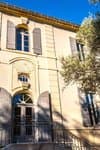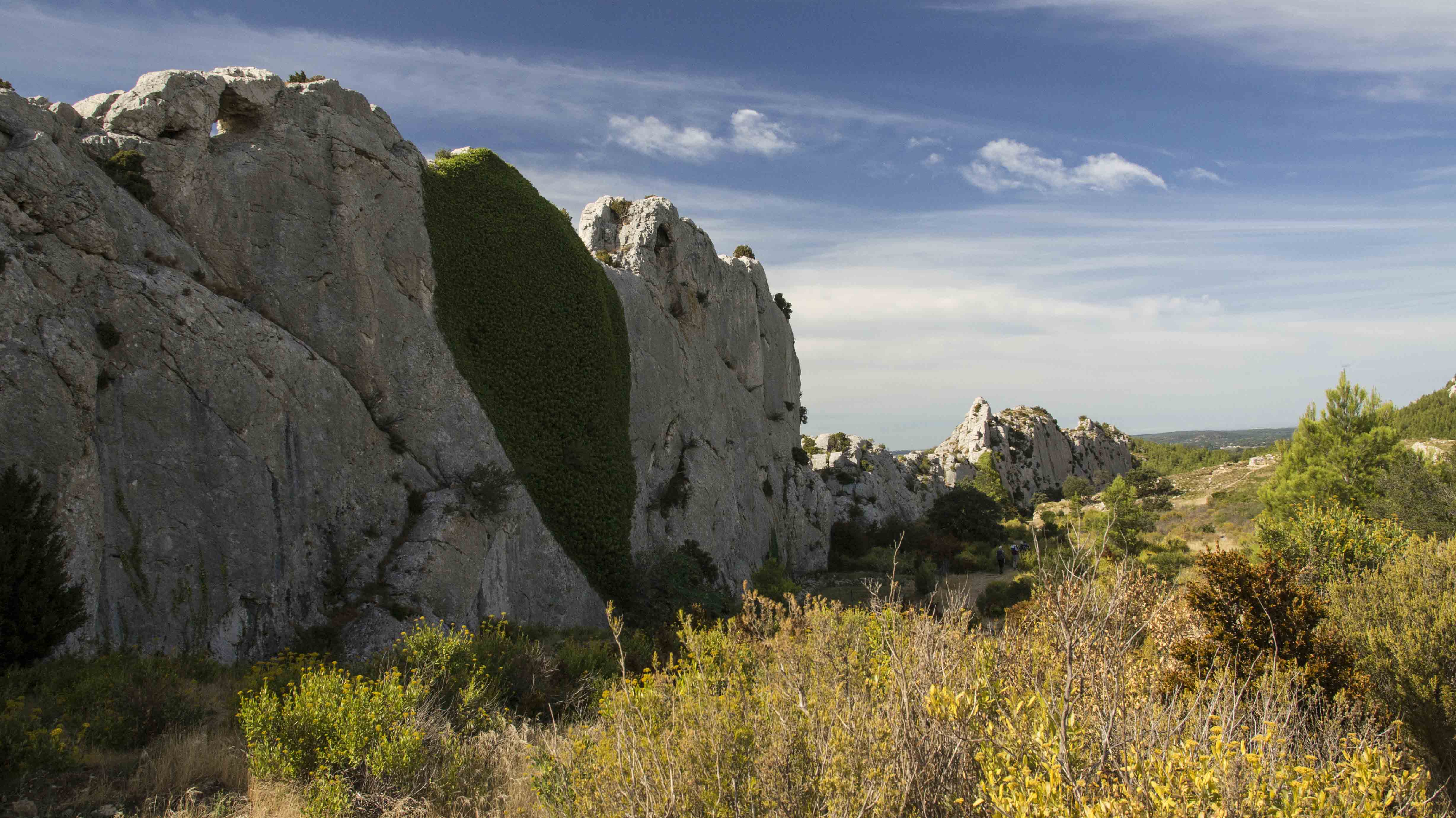
MOURIES - Caisses de Jean Jean
& Laquo; This loop is one of my favourite walks in the Alpilles. Here, we feel the presence of mankind through numerous imprints it has left. With greenhearts shaped by ivy on the picturesque cliffs and different landscapes, there is a very diversified fauna and flora. It is the kingdom of the European eagle-owl, but in winter a little remarkable climber also shows up regularly: , the Wallcreeper. & Raquo; Lisbeth Zechner, Project Manager LIFE Alpiller RNP.
8 points of interest

Borne se trouvant sur le sentier - ©Jason Gaydier - PNR Alpilles  Patrimony and history
Patrimony and historyChemin Faisan
As part of an educational action of the Park, the environmental education association Chemin Faisan has created a booklet which accompanies the milestones you can see, made by SEGPA classes (special needs educational division) of the René Cassin high school of Tarascon and 9 classes of the Mouriès school. The booklet along with the milestones allow the young audience to discover in an educational way the Caisses de Jean Jean and its heritage. Each colour present on the milestones symbolizes a theme explored in the book.
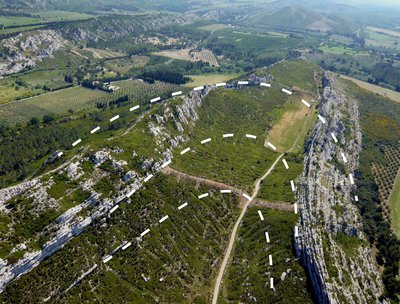
Tracé de l'anticlinal des Caisses de Jean-Jean, érodé en combe - ©Alain Laforest - GAM  Geology
GeologyVertical cliffs
200 million years ago, a gigantic ocean, Tethys, caused the formation of the rocks by its water movements. Following the collision of the African and Eurasian plates then new movements, these vertical rocks were formed. If we take a closer look at these rocks, it is still possible to find traces of shells, fossils which survived for millions of years, and are witnesses to this past.
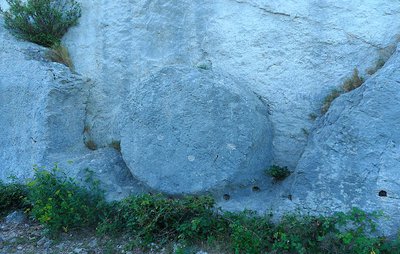
La meule inachevée - ©Jason Gaydier - PNR Alpilles  Savoir-faire
Savoir-faireThe round stone
If you go into the scrubland to reach the cliff, you will see by looking, a round stone carved into the rock. In the past, man would carve into the cliff to create wheels for the mills to grind grains or to crush olives. This unfinished wheel has been around probably since the 17th century. It is said that cliff carving was done in the winter, stone carvers would put water into the holes around the stone. The water would freeze allowing the stone to break.
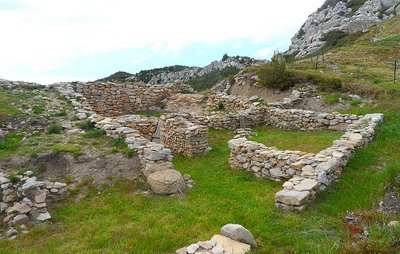
Vestige de l'oppidum gaulois - ©Jason Gaydier - PNR Alpilles  Patrimony and history
Patrimony and historyThe Gallic oppidum
A Gallic oppidum (fortified village) stood here in the 6th century BC, date of the first rampart placed to protect the village. But there were two ramparts and cliffs protecting the several thousand Gauls then living in the Caisses. They had food through farming and crops they grew in the plains. Archaeological excavations have shown that this site has subsequently experienced the influence of the Romans and Greeks.

Couple de guêpiers - ©Rémi Sérange - PNR Alpilles  Fauna
FaunaThe European bee-eater
The European Bee-eater is characterized by its the many colours: yellow and black head, brown back, abdomen ranging from blue-green to turquoise blue, green tail and red iris make up this magnificent bird. Often perched at the top of a dead tree, it can be mistaken when far away with a swallow because it flies in the same way, especially when hunting, where it will alternate flapping their wings and flying steady.
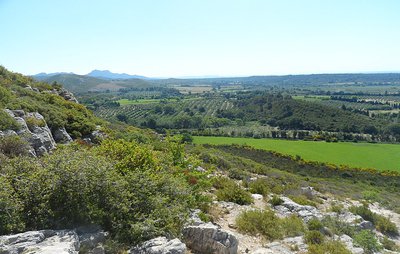
Vue sur la plaine et les Opies - ©Jason Gaydier - PNR Alpilles  Panorama
PanoramaThe view of the Crau
From this viewpoint, at the end of the Caisses de Jean-Jean, it is possible to admire not only the peak of Opies to the east, but especially the plain of Crau to the south, stretching before your eyes in an endless view. Here, you can distinguish a patchwork landscape composed the Golf de Servanes and different cultivations (olive groves, vineyards, fruit trees), separated by paths and multiple cypress hedges.
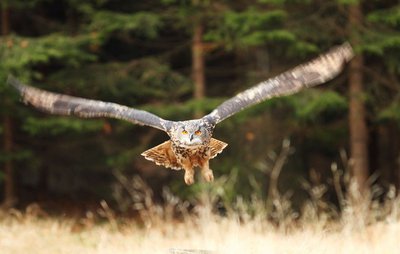
Hibou Grand-duc - ©DR  Fauna
FaunaThe Great-Owl
Who does not know the Grand Duke of Europe? Europe's largest owl, it nests all year in the cliffs and saw its population increase. Many grand dukes peacefully sleep during the day, waiting for the night to hunt. As the Bonelli's eagle, raptor is a super predator that feeds on small mammals such as hares, hedgehogs, and other birds.

Canal de la vallée des Baux - ©Jason Gaydier - PNR Alpilles  Water and rivers
Water and riversThe Baux valley canal
This canal, measuring 53km long, was subject to a long process of reflection and design. Designed in 1792, the project will be launched over a century later, in 1914. In a landscape of steppe, it was important to develop human presence and the economy as a hydraulic network irrigates the territory to help the crops survive. This canal supplies all to itself the southern part of the Alpilles.
Description
From the car park, continue on the road to the golf course of Servanes. At the entrance of the golf courses, continue on the road to go around it. At the crossroads with two paths, continue on the road until the next junction.
1 & Ndash; At the junction, follow the gravel path towards the car park for climbing "Les Caisses de Jean-Jean Nord". At 200m, pass the gate and continue until "Les Caisses de Jean-Jean". Continue on the footpath after the archaeological site.
2 – At the viewpoint, take the small stony steep path leading down to the country road. Once on it, turn left and continue into the forest then along olive groves and a few constructions by man. Stay on the path until the paved road.
3 – The road within sight, turn left and follow it until the next junction with the sign of the car park for climbing. The canal of the Baux valley, which first goes along the road, will make way for new olive groves which it supplies with water.
1 – Continue straight on the road until the starting point and end the tour.
- Departure : Car park of Castellas, Mouriès
- Arrival : Car park of Castellas, Mouriès
- Towns crossed : Mouriès and Maussane-les-Alpilles
Forecast
Altimetric profile
Recommandations
A booklet has been created and published by the association Chemin Faisan and the Alpilles Regional Nature Park. Don't forget to get it to discover the Caisses de Jean-Jean in a fun way!
Come rather early in the morning (7.00) or late afternoon (18.00) to enjoy the tranquillity of the area and to see and hear the birds sing.
Bring a pair of binoculars.
Information desks
House of the Alpilles Regional Nature Park
2, boulevard Marceau, 13210 Saint-Rémy-de-Provence
Located in the heart of the city centre of Saint-Rémy-de-Provence, the House of the Alpilles Nature Park welcomes you to its completely renovated premises. This new vibrant place is multifunctional: it accommodates the Park's engineering team but also has a public reception space and showrooms. A true resource centre of the Park's heritage, it aims to support and promote locals, visitors and tourists on all 16 municipalities of the Park.
Open Monday to Friday, from 9 am at 12:30 pm and from 1:30 pm to 5 pm.
Free admission.
OTI Alpilles-en-Provence
Place Jean Jaurès, 13210 Saint-Rémy-de-Provence
Access and parking
From the centre of Mouriès, follow the direction of Eygalières. After the roundabout, turn left of the statue, towards Servanes. Continue straight to the car park which will be on the right.
Parking :
Report a problem or an error
If you have found an error on this page or if you have noticed any problems during your hike, please report them to us here:

